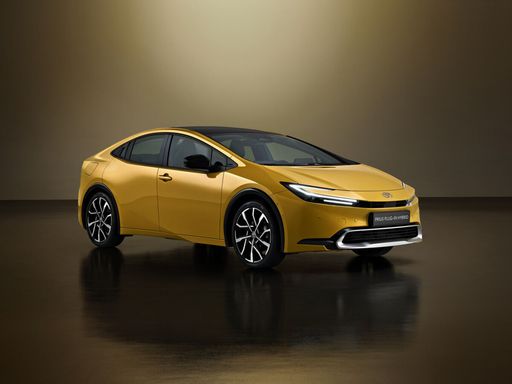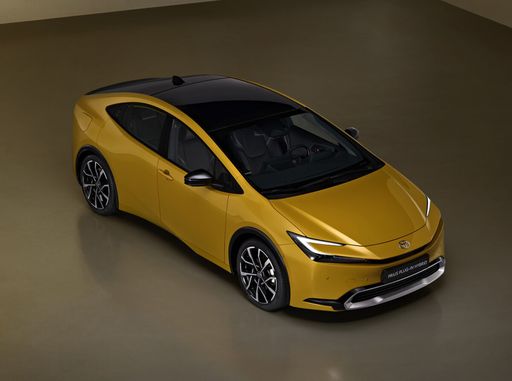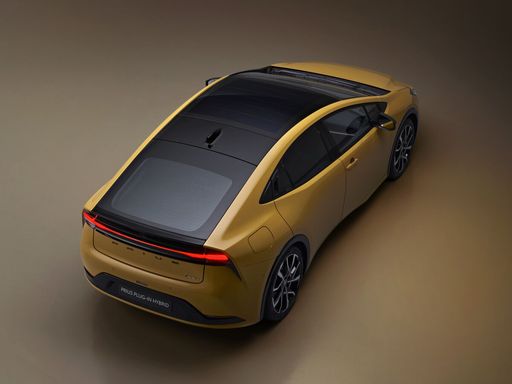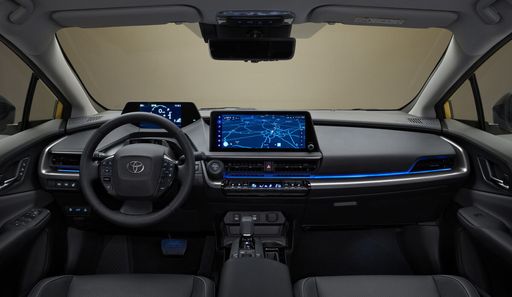BYD ETP3 vs Toyota Prius – Differences & prices compared
Compare performance, boot space, consumption and price in one view.
Find out now: which car is the better choice for you – BYD ETP3 or Toyota Prius?
The BYD ETP3 (Cargo Van) comes with a Electric engine and Automatic transmission. In comparison, the Toyota Prius (Hatchback) features a Plugin Hybrid engine with Automatic transmission.
When it comes to boot capacity, the BYD ETP3 offers , while the Toyota Prius provides 284 L – depending on how much space you need. If you’re looking for more power, decide whether the 136 HP of the BYD ETP3 or the 223 HP of the Toyota Prius suits your needs better.
In terms of consumption, the values are per 100 km for the BYD ETP3, and 0.50 L for the Toyota Prius.
Price-wise, the BYD ETP3 starts at 31600 £, while the Toyota Prius is available from 39400 £. Compare all the details and find out which model fits your lifestyle best!
BYD ETP3
The BYD ETP3 is a versatile electric van that seamlessly blends functionality with environmental consciousness. Its modern design is complemented by a spacious interior, making it ideal for both urban deliveries and day-to-day personal use. Advanced technology features ensure a smooth and efficient driving experience, setting a new standard in the electric vehicle market.
details @ press.bydauto.be
@ press.bydauto.be
Toyota Prius
The Toyota Prius stands as a pioneer in the realm of hybrid vehicles, offering an eco-friendly driving alternative with its innovative technology. Its aerodynamic design and comfortable interior make it a practical choice for those looking to reduce their carbon footprint without sacrificing style. Additionally, the Prius boasts a reputation for reliability and efficiency, contributing to its lasting popularity among environmentally conscious drivers.
details @ Toyota
@ Toyota
 @ Toyota
@ Toyota
 @ Toyota
@ Toyota
 @ Toyota
@ Toyota

|

|
|
|
|
Costs and Consumption |
|
|---|---|
|
Price
31600 £
|
Price
39400 - 45800 £
|
|
Consumption L/100km
-
|
Consumption L/100km
0.5 - 0.7 L
|
|
Consumption kWh/100km
-
|
Consumption kWh/100km
-
|
|
Electric Range
233 km
|
Electric Range
72 - 86 km
|
|
Battery Capacity
-
|
Battery Capacity
-
|
|
co2
0 g/km
|
co2
12 - 17 g/km
|
|
Fuel tank capacity
-
|
Fuel tank capacity
40 L
|
Dimensions and Body |
|
|---|---|
|
Body Type
Cargo Van
|
Body Type
Hatchback
|
|
Seats
2
|
Seats
5
|
|
Doors
5
|
Doors
5
|
|
Curb weight
1640 kg
|
Curb weight
1620 - 1630 kg
|
|
Trunk capacity
-
|
Trunk capacity
284 L
|
|
Length
4460 mm
|
Length
4599 mm
|
|
Width
1720 mm
|
Width
1782 mm
|
|
Height
1875 mm
|
Height
1470 mm
|
|
Payload
780 kg
|
Payload
365 - 375 kg
|
Engine and Performance |
|
|---|---|
|
Engine Type
Electric
|
Engine Type
Plugin Hybrid
|
|
Transmission
Automatic
|
Transmission
Automatic
|
|
Transmission Detail
-
|
Transmission Detail
-
|
|
Drive Type
Rear-Wheel Drive
|
Drive Type
Front-Wheel Drive
|
|
Power HP
136 HP
|
Power HP
223 HP
|
|
Acceleration 0-100km/h
-
|
Acceleration 0-100km/h
6.80 s
|
|
Max Speed
100 km/h
|
Max Speed
177 km/h
|
|
Torque
180 Nm
|
Torque
-
|
|
Number of Cylinders
-
|
Number of Cylinders
4
|
|
Power kW
100 kW
|
Power kW
164 kW
|
|
Engine capacity
-
|
Engine capacity
1998 cm3
|
General |
|
|---|---|
|
Model Year
2023
|
Model Year
2023
|
|
CO2 Efficiency Class
A
|
CO2 Efficiency Class
B
|
|
Brand
BYD
|
Brand
Toyota
|
BYD ETP3
A Revolution in Electric Transport: The BYD ETP3
The BYD ETP3, a breakthrough in the realm of electric light-commercial vehicles, epitomises innovation and efficiency. As a trailblazer from the Chinese automotive giant BYD, the ETP3 is designed to redefine the electric vehicle (EV) market, blending practicality with cutting-edge technology. This article delves into the technical details and groundbreaking innovations that make the BYD ETP3 an intriguing contender in the field of green transportation.
Powertrain and Performance: Setting New Standards
At the heart of the BYD ETP3 lies an electric motor delivering an impressive 136 PS (100 kW), with a rear-wheel drive configuration that ensures a robust performance. This setup promises a seamless driving experience augmented by a torque of 180 Nm, rendering the ETP3 adept at handling the rigorous demands of logistics and commercial tasks.
The vehicle's 233 km electric range reaffirms its position as a practical and efficient choice for city-based transport, reducing the need for frequent charging stops and enhancing productivity. The maximum speed of 100 km/h ensures the ETP3 remains steady and safe on urban roadways.
Innovative Design and Practicality
The BYD ETP3, while primarily focused on functionality, does not compromise on aesthetics. The sleek exterior, extending to 4,460 mm in length, 1,720 mm in width, and 1,875 mm in height, is thoughtfully designed to maximise both aerodynamic efficiency and load space. With a generous payload capacity of 780 kg, the ETP3 is poised to meet the diverse needs of urban businesses and tradespeople.
Built on a foundation of innovation, the vehicle employs a reduction gearbox to ensure smooth transitions, enhancing the overall driving experience. This technological innovation positions the ETP3 as an easy-to-handle and responsive option for urban and suburban environments.
A Commitment to Sustainability
One of the standout features of the BYD ETP3 is its commitment to environmental sustainability. With a CO2 emission rating of 0 g/km, it represents a significant step forward in reducing the carbon footprint of commercial vehicles. This remarkable achievement is complemented by its CO2 efficiency class rating of A, making it not only a financially savvy option in terms of operational costs but also an environmentally responsible choice.
The Comfort Line: Meeting Everyday Needs
The ETP3 comes equipped with the 'Comfort' trim, manifesting in a range of features designed to enhance user experience. With room for two seats, this vehicle balances free space for cargo with driver and passenger needs, ensuring comfort without compromising functionality.
Conclusion: BYD ETP3 - A Glimpse into the Future
The BYD ETP3 emerges as a frontrunner in the electric van market, combining efficiency, sustainability, and practical design. Its array of thoughtful innovations and technical specifications render it highly appealing for any business prioritising eco-friendly transport solutions. As the automotive industry continues to evolve, the ETP3 remains at the forefront, representing the future of logistics and urban transport.
Toyota Prius
The All-New Toyota Prius: Revolutionising Efficiency and Performance
The Toyota Prius, a name synonymous with hybrid innovation, has once again shown why it remains at the forefront of eco-friendly automotive technology. The latest models have enhanced technical features and innovations, setting new standards for efficiency and driving experience.
Hybrid Performance: A Leap Forward
The latest Prius models employ a sophisticated 2.0 litre Plug-in Hybrid system that flawlessly melds petrol and electric power. With a power output of 223 PS, it propels the Prius with impressive dynamism, reaching 0-100 km/h in just 6.8 seconds. This performance-oriented aspect of the Prius does not compromise on efficiency, with an astonishing fuel consumption ranging from 0.5 to 0.7 L/100km.
Electric Range and Efficiency
One of the key highlights of the new Prius is its substantial electric-only range. Depending on the variant, it can travel between 72 to 86 km on electric power alone, making it an ideal choice for urban commutes where zero emissions are preferred. The hybrid system's CO2 emissions are remarkably low, between 12 and 17 g/km, contributing to its CO2 Efficiency Class B rating.
Engineering Excellence with CVT
The Prius is equipped with a state-of-the-art Continuously Variable Transmission (CVT), ensuring a smooth and efficient drive. This advanced transmission supports the front-wheel-drive layout, delivering power seamlessly and enhancing driving pleasure without sacrificing fuel economy.
Stylish Design and Comfort
Designed as a sleek five-door hatchback, the Prius offers a comfortable and spacious interior with seating for five passengers. It measures 4599 mm in length, 1782 mm in width, and 1470 mm in height, offering a practical balance of size and comfort. The boot space, while tailored for the hybrid battery, still provides a decent 284 litres of storage.
Cost Efficiency
The running costs of the Prius are competitive, with monthly expenses estimated between €1064 and €1188, and cost per kilometre ranging from 42.6 to 47.5 cents. Its efficient design results in a maximum speed of 177 km/h and a practical fuel tank size of 40 litres, ensuring less frequent stops on longer journeys.
Conclusion: The Prius Legacy Continues
The Toyota Prius continues to lead by example in the realm of hybrid technology. Combining impressive power with unmatched efficiency and a sophisticated driving experience, it is clear that the Prius remains a compelling choice for the environmentally conscious driver. Its innovative features and favourable cost metrics only bolster its appeal in the modern automotive landscape.
Which drive types are available for the BYD ETP3?
Available as Rear-Wheel Drive.
The prices and data displayed are estimates based on German list prices and may vary by country. This information is not legally binding.
